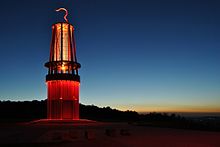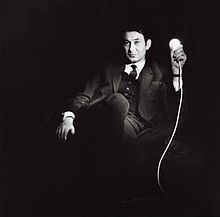- Otto Piene
-
Otto Piene 
Otto Piene in 2007Birth name Otto Piene Born 1928
Bad LaaspheNationality German Field kinetic art, Performance art Movement Zero (art) Otto Piene (born 18 April 1928 in Bad Laasphe, Province of Westphalia) is a German artist. He lives and works in Düsseldorf and Groton, Massachusetts.
Contents
Biography
Otto Piene was born 1928 in Bad Laasphe and was raised in Lübbecke. Between 1949 and 1953 he studied painting and art education at the Academy of Art in Munich and the Kunstakademie Düsseldorf. He was lecturer at the Fashion Institute in Düsseldorf. From 1952 to 1957 he studied philosophy at the University of Cologne.
He was a Visiting Professor at the University of Pennsylvania beginning in 1964. From 1968 to 1971, he was the first Fellow of the MIT Center for Advanced Visual Studies (CAVS), founded by György Kepes. In 1972, he became a Professor of Environmental Art at MIT. In 1974 he succeeded Kepes as director of the CAVS, in which position he served until September 1, 1993.
The University of Maryland, Baltimore County awarded Piene an honorary Doctor of Fine Arts in 1994. In 1996, he received the Sculpture Prize of the American Academy of Arts and Letters, New York.
With Günther Uecker, Heinz Mack and Mattijs Visser he founded in 2008 the international ZERO foundation. The foundation has the ZERO archives from the three Düsseldorfer artists as well as documents and photos from other related artist.
Works

In 1957, Piene and Heinz Mack founded the group ZERO. In 1961, Günther Uecker joined the group. In 1957 he developed the Grid Picture, a type of stencilled painting made from half-tone screens with regularly arranged points in single colours (yellow, silver, white or gold), for example Pure Energy (1958; New York, MOMA). Piene's work then developed in a variety of forms. The Lichtballette ("light ballet") (from 1959) were a development of the Grid Pictures: light from moving torches was projected through grids, thus extending and stimulating the viewer's perception of space. This series of works is inspired by László Moholy-Nagy's Light Space Modulator (1930) and Fernand Léger's Ballet Mécanique (1924).[1]
Also in 1959, the combination of these grids with sources of fire (candles, gas-burners) produced smoke-traces and fire paintings, in which the paint was burnt. Piene created these Rauchbilder ("smoke pictures") as a reference to elementary natural energies. In the "fire paintings", he lightly burns a layer of solvent on pigmented paper, developing organic forms from the remnant, or the soot. He continues the practice of "smoke pictures" through today. Fire and smoke (their traces) are important elements in these pictures. Silver Fire of 1973 is an example of a "smoke picture". He experimented also with multimedia combinations. In 1963, together with Günther Uecker and Heinz Mack, he became spokesman of Neuen Idealismus ("the new idealism"). Piene is also noted for exploring new uses for broadcast television. In 1968, along with Aldo Tambellini, he produced Black Gate Cologne, which is cited as one of the first television programs produced by experimental visual artists.
1967 marks Piene's involvement with Sky art, a term he coined in 1969 and which allowed him to use landscape and cities themselves as the focal point of his work. For the closing of the 1972 Summer Olympics in Munich, Piene created the sky work Olympic Rainbow, made up of five differently coloured helium-filled polythene tubes, each one 600 m long. Between 1981 and 1986 Piene organized four Sky art conferences in the USA and Europe.[2]
He took a stab at industrial design in the 1970s with a 500-piece run of the upscale Suomi tableware by Timo Sarpaneva that Piene decorated for the German Rosenthal porcelain maker's Studio Linie.[3]
Working as the director of the Center for Advanced Visual Studies (C.A.V.S.) at the Massachusetts Institute of Technology, Piene collaborated in the design of the kinetic sculpture performance Centerbeam first exhibited in Kassel, Germany in 1977. The C.A.V.S. allowed artists to work using sophisticated techniques and scientific partnership, promoting a highly collaborative environment.[4]
 Otto Piene, Das Geleucht (Mining Lamp), steel, glass, LEDs, 30 m high, 1998-2007 (Halde Rheinpreußen, Moers, Germany)
Otto Piene, Das Geleucht (Mining Lamp), steel, glass, LEDs, 30 m high, 1998-2007 (Halde Rheinpreußen, Moers, Germany)
In 1978, Piene was commissioned by the Smithsonian Art Collectors Program to create a print to benefit the educational and cultural programs of the Smithsonian Associates. The print was to commemorate a Washington, D.C. festival much like the 1977 exhibition in Kassel. Three lithographs resulted, all titled, Centerbeam, one of which hangs in the ongoing exhibition, Graphic Eloquence, in the S. Dillon Ripley Center in the National Mall.
In 1999, Piene presented his idea of a statue called Das Geleucht in the Ludwig Galerie Schloss Oberhausen for the first time. That monument in the form of a mining lamp ought to be built on the spoil tip Halde Rheinpreußen in Moers, with illumation at night. That project enthused the publicity but as recently as 2006 sponsors were found. Until 2007, the 30 metres (98 ft) high monument lightened the spoil tip every night.[5][6]
Exhibitions
Piene had his first solo exhibition at Galerie Schmela, Düsseldorf, in 1959. With Light Ballet, he debuted at Howard Wise Gallery, New York, in 1966. He represented Germany at the Venice Biennale in 1967 and 1971, and exhibited at documenta in Kassel, Germany, in 1959, 1964 and 1977.[7] In 1985, he exhibited at the São Paulo Biennial.
Piene's solo exhibitions include retrospectives at the Kunstmuseum im Ehrenhof, Düsseldorf, in 1996 and at the Prague City Gallery Prague, in 2002, and a show at the Museum am Ostwall, Dortmund in 2008-2009.[8]
Position on the art market
Sotheby's established a first record for works by Otto Piene when it sold Rauchbild, a 1961 oil and charcoal on canvas from the Lenz-Schoenberg collection, for £223,250 ($329,000) in February 2010.[9] Only a few months later, Piene's Kleine Sonne (1963–64) was sold for £85,250 ($126,937)[10] by the Lauffs Collection at Christie's London.
References
- ^ Jonathan T.D. Neil, Otto Piene: Light Ballet and Fire Paintings, 1957-1967 Art Review, May 4, 2010. Accessed 31 January 2011.
- ^ Stephan von Wiese, Otto Piene MoMA - The Collection. Source: Oxford University Press. Accessed 31 January 2011.
- ^ [Anon.] (1976). "Faenza-Goldmedaille für SUOMI". Artis 29: 8. ISSN 0004-3842.
- ^ Piene, Otto; Goldring, Elizabeth (c1980.). Centerbeam. Cambridge, Massachusetts: Center for Advanced Visual Studies, Massachusetts Institute of Technology. ISBN 0-262-66047-4.
- ^ http://www.das-geleucht.de/index.htm
- ^ http://www.route-industriekultur.de/panoramen/halde-rheinpreussen/halde-rheinpreussen.html
- ^ Otto Piene - Biography Axel Vervoordt Gallery. Accessed 31 January 2011.
- ^ Otto Piene: Light Ballet and Fire Paintings, 1960-1967 Sperone Westwater Gallery, 19 March 2010. Accessed 31 January 2011.
- ^ Judd Tully, Fire Paintings and Sky Art: A Q&A with Otto Piene ARTINFO, May 17, 2010. Accessed 31 January 2011.
- ^ Otto Piene (b. 1928) Kleine Sonne, Sale 7861 Christie's London, Post War and Contemporary Art Day Auction, 1 July 2010. Accessed 31 January 2011.
Publications
- "ZERO, Internationale Künstler Avantgarde", exhibition catalog published by Museum Kunst Palast and Cantz, with essays by Jean-Hubert Martin, Valerie Hilling, Catherine Millet and Mattijs Visser, Düsseldorf/Ostfildern 2006, ISBN 3-9809060-4-3
- "Artempo, Where Time Becomes Art", exhibition catalog published by Musei Civici Veneziani, with essays by Jean-Hubert Martin, Heinz Norbert Jocks, Massimo Cacciari, Giandomenico Romanelli and Mattijs Visser, MER Paper Kunsthalle Ghent 2007, ISBN 978-90-76979-47-2
- "ZERO in NY", exhibition catalog edited by Mattijs Visser, published by the ZERO foundation and Sperone Westwater, New York/Düsseldorf/Ghent 2008, ISBN 978-90-76979-73-1
- Busch, Julia M., A Decade of Sculpture: the New Media in the 1960's (The Art Alliance Press: Philadelphia; Associated University Presses: London, 1974) ISBN 0-87982-007-1
- Radford, Georgia and Warren Radford, "Sculpture in the Sun, Hawaii's Art for Open Spaces", University of Hawaii Press, 1978, 95.
External links
Categories:- 1928 births
- Living people
- People from Bad Laasphe
- German artists
- People from the Province of Westphalia
- Kunstakademie Düsseldorf alumni
Wikimedia Foundation. 2010.

